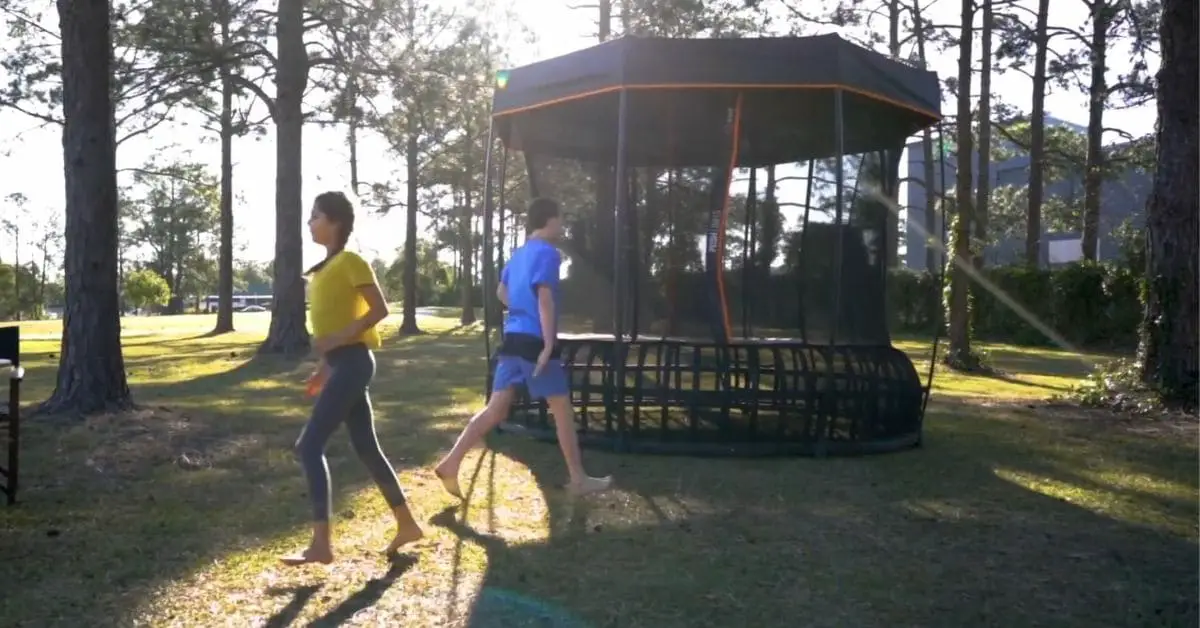Trampolines are a popular recreational item for families, providing endless hours of fun and exercise. Installing a trampoline in your backyard is a great way to encourage your kids to get outside and be active, but it can also be an expensive investment.
The cost of installing a trampoline depends on various factors, such as the size and type of trampoline, the quality of materials used, and the installation method.
If you are considering installing a trampoline, it’s important to understand the costs involved to ensure you can budget appropriately. In general, the price of a trampoline can range from a few hundred dollars for a basic model to several thousand dollars for a larger, more advanced version.
Additionally, installation costs vary widely depending on whether you install the trampoline or hire a professional. It’s essential to weigh each option’s pros and cons before deciding.
In this article, we will explore the factors that affect the cost of installing a trampoline and provide the information you need to make an informed decision.
How much does it cost to install a trampoline: Installing a trampoline can be a significant investment, with costs ranging from a few hundred to several thousand dollars. Factors such as trampoline size, quality, and installation method contribute to the price. Proper research and budgeting are essential before making a decision.
How much does it cost to install a trampoline?
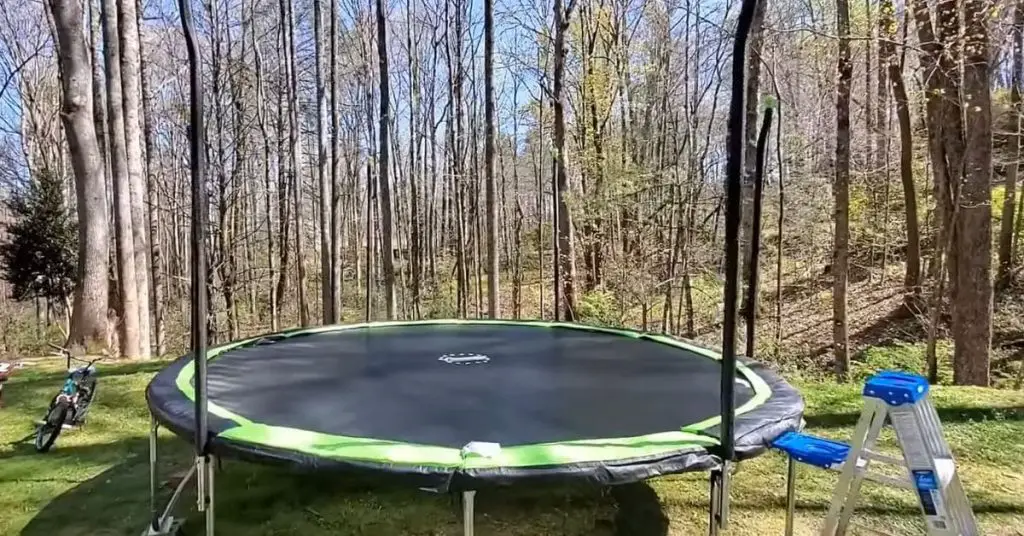
The cost of installing a trampoline can vary depending on several factors. A trampoline can range from $200 to $2,000 or more. Factors that can influence the cost include the size of the trampoline, the quality of materials, any additional features or accessories, and whether you choose to install it yourself or hire a professional.
Additionally, there may be additional expenses such as safety equipment, ground preparation, and delivery fees. It’s important to consider your budget and carefully compare prices and options before purchasing to ensure you get the best value for your money.
Above-Ground Trampolines
Above-ground trampolines are popular among families as they are easy to set up and require less maintenance than inground trampolines. They are typically built on top of the ground and do not require excavation, making them more affordable and accessible to a wider range of users.
we will discuss the benefits and drawbacks of above-ground trampolines, their cost, and the optional accessories that can enhance the trampoline experience.
Explanation of Above-Ground Trampolines
Above-ground trampolines are designed to sit on top of the ground and are supported by a frame and legs. They are usually made of galvanized steel frames and come with a jumping mat, springs, and a safety enclosure.
The frames are often coated with a rust-resistant finish to protect them from outdoor elements. Above-ground trampolines are available in various shapes and sizes, such as round, oval, and rectangular, and can be customized with different colors and designs.
One of the main benefits of above-ground trampolines is their ease of installation. They do not require excavation or any major construction and can be assembled in a matter of hours with minimal tools and equipment.
They are also more portable than inground trampolines, as they can be disassembled and moved to another location if necessary. This is especially useful for families who are renting or who do not have a permanent outdoor space.
Another advantage of above-ground trampolines is that they are less expensive than inground trampolines. The cost of an above-ground trampoline varies depending on the size, shape, and quality of the materials used.
An above-ground trampoline can range from $200 to $1,500 or more. However, even the most expensive above-ground trampolines are still cheaper than inground trampolines, which can cost anywhere from $3,000 to $10,000.
Cost of Above-Ground Trampolines
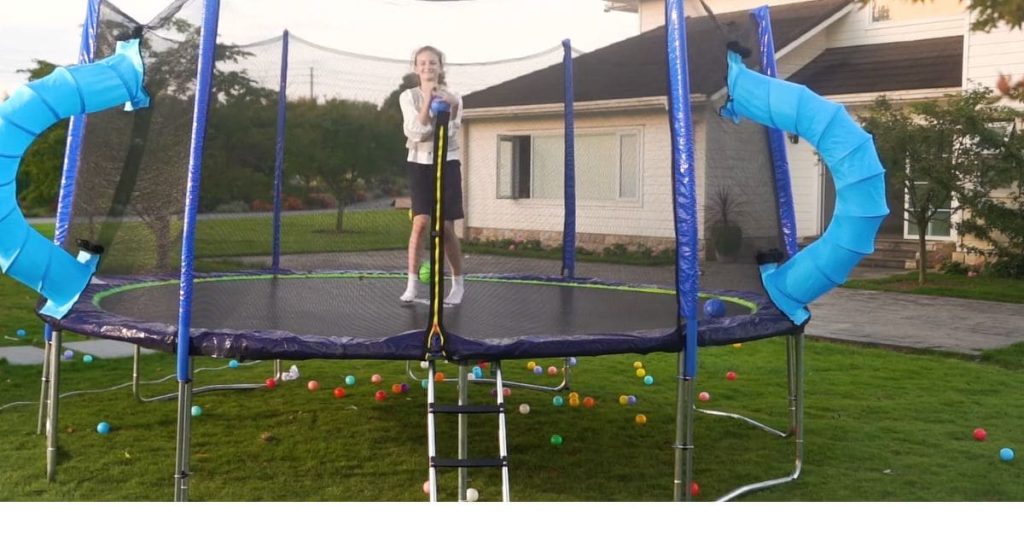
As mentioned above, the cost of an above-ground trampoline depends on several factors, including the size, shape, and quality of the materials used. The average cost of a mid-range above-ground trampoline is between $500 and $1,000. However, some cheaper models are available, starting at around $200, and some more expensive models can cost over $1,500.
When considering the cost of an above-ground trampoline, it is important to also factor in the cost of any optional accessories that may be necessary or desirable. Some of the most common accessories for above-ground trampolines include:
Ladder: A ladder can make climbing onto and off the trampoline easier, especially for younger children.
Anchor Kit: An anchor kit can help secure the trampoline to the ground, preventing it from tipping over in windy conditions.
Weather Cover: A weather cover can help protect the trampoline from rain, snow, and other outdoor elements when it is not in use.
Basketball Hoop: A basketball hoop can add a fun and challenging element to the trampoline experience, especially for older children and adults.
Optional Accessories for Above-Ground Trampolines
In addition to the trampoline itself, there are a variety of accessories available for above-ground trampolines that can enhance your jumping experience and increase the safety and longevity of your trampoline. Here are some of the most popular options:
Safety Enclosure: A safety enclosure is a must-have accessory for any trampoline, especially if children will be using it. The enclosure attaches to the trampoline’s frame and creates a barrier around the jumping area to prevent falls. Look for enclosures made of durable, UV-resistant material and with a locking door for added safety.
Ladder: If your trampoline is tall, a ladder can make it easier to get in and out. Look for a sturdy ladder that attaches securely to the trampoline’s frame.
Weather Cover: A weather cover can protect your trampoline from the elements, helping to extend its lifespan. Look for a cover made of durable, weather-resistant material that fits snugly over the trampoline.
Anchor Kit: If you live in a windy area or your trampoline is exposed to strong winds, an anchor kit can help keep it in place. Look for an anchor kit that includes sturdy stakes and straps to secure the trampoline to the ground.
Basketball Hoop: A basketball hoop attachment can add another element of fun to your trampoline. Look for a hoop designed specifically for trampolines and made of durable, weather-resistant materials.
Spring Cover: A spring cover can protect the springs of your trampoline from weather and wear and tear, helping to extend their lifespan. Look for a cover made of durable, UV-resistant material that fits securely over the springs.
Trampoline Mat Cleaner: Over time, the jumping mat of your trampoline can become dirty and stained. A trampoline mat cleaner can help keep the mat looking like new. Look for a cleaner that is safe for use on trampoline materials and won’t damage the mat or springs.
Inground Trampolines
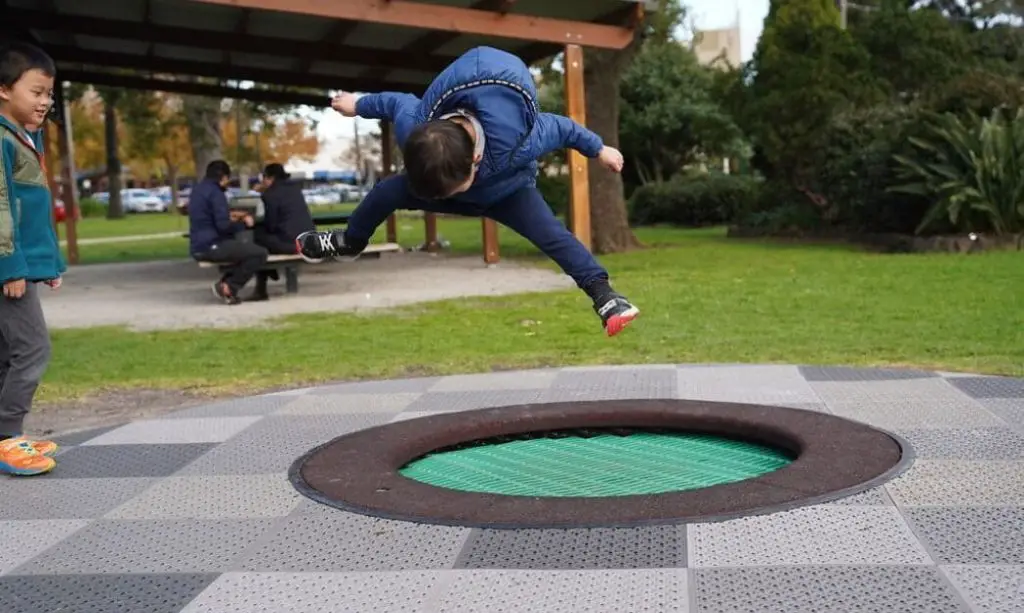
An inground trampoline is installed by digging a hole in the ground and creating a stable base for the trampoline. The trampoline is then installed into the hole, filling the surrounding area to create a seamless and safe environment.
Inground trampolines are typically more secure than their above-ground counterparts, as they are less likely to tip over or become damaged during strong winds.
Cost of Inground Trampolines
The cost of an inground trampoline can vary depending on some factors. The size and quality of the trampoline, as well as the depth of the hole required for installation, are the two most significant factors that affect the cost of an inground trampoline.
An inground trampoline can cost anywhere from $1,500 to $5,000 or more. While this may seem like a hefty price tag, many homeowners find that the benefits of an inground trampoline make the cost well worth it.
Benefits of Inground Trampolines
There are many benefits to having an inground trampoline, including:
Aesthetics – Inground trampolines are sleek and integrated into the surrounding landscape, creating a cohesive look that doesn’t detract from the beauty of your outdoor space.
Safety – Inground trampolines are typically more secure than above-ground trampolines, as they are less likely to tip over or damage during strong winds.
Accessibility – Inground trampolines are easier for children and adults alike, as they do not require climbing up a ladder or stairs to get onto the trampoline.
Versatility – Inground trampolines can be used for various activities, from exercise and fitness to pure entertainment for children and adults alike.
Durability – Inground trampolines are designed to last for many years, providing a long-lasting and reliable source of entertainment for your family.
Increased home value – An inground trampoline can increase the value of your home, making it a worthwhile investment for homeowners looking to boost their property value.
Inground Trampoline Cost Factors
When installing an inground trampoline, several factors contribute to the project’s overall cost. While many people are drawn to the idea of an inground trampoline due to its safety features and sleek appearance, it is important to consider all of the expenses that may come with this type of installation.
we will discuss three key factors that go into the cost of an inground trampoline: the depth of the hole, finishing stones and retaining walls, and water issues.
Depth of the Hole
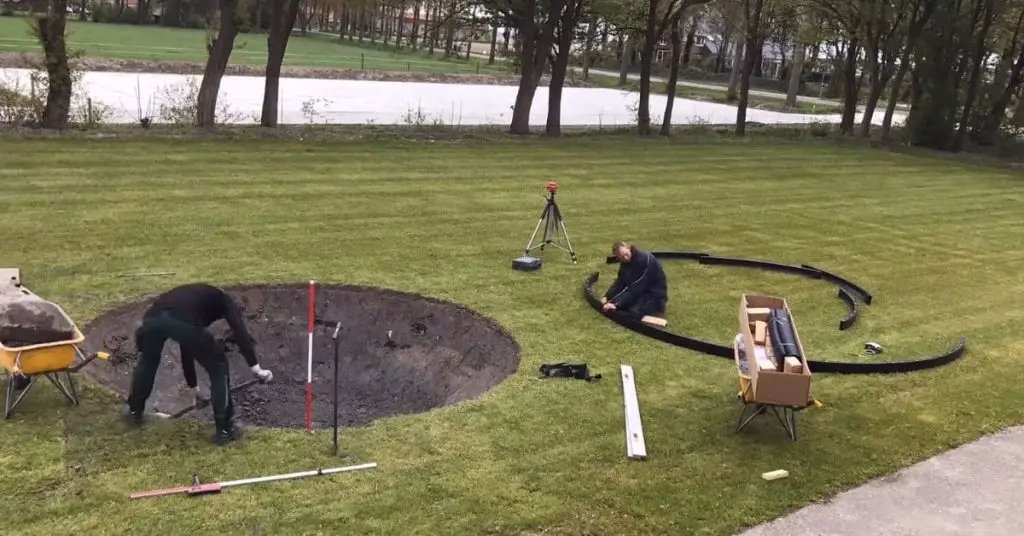
One of the main factors that affect the cost of an inground trampoline is the depth of the hole that needs to be dug for installation. To create a safe and stable base for the trampoline, the hole must be dug to a certain depth, usually around 2-3 feet. The deeper the hole, the more excavation work will be done, which can drive up the project’s cost.
The depth of the hole also affects the amount of soil that needs to be removed from the installation site. This can be a major factor in the overall cost, especially if the soil needs to be hauled away from the site or if special equipment is required to remove it.
In addition to excavation costs, there may be costs associated with grading the installation site to ensure it is level and stable.
Finishing Stones and Retaining Walls
Another factor contributing to the cost of an inground trampoline installation is finishing stones and retaining walls. These features can add to the overall aesthetic appeal of the trampoline, but they can also add to the cost of the project.
Finishing stones are used to create a decorative border around the trampoline. They can be made from various materials, including brick, stone, or concrete. The stones themselves will vary depending on the material, but additional costs may be associated with installing the stones, such as labor and equipment rental.
Retaining walls are used to provide support and stability to the installation site. They are especially important if the installation site is on a slope or uneven terrain. The cost of retaining walls will depend on the size and type of wall needed and any additional labor or equipment costs associated with installation.
Water Issues
Finally, water issues can also affect the cost of an inground trampoline installation. This is especially true if the installation site is prone to flooding or has poor drainage. In these cases, additional measures may be needed to prevent water from accumulating around the trampoline, which can cause damage over time.
Some possible solutions to water issues include installing a drainage system around the installation site, using a layer of gravel or crushed stone underneath the trampoline to promote drainage, or even installing a sump pump to remove excess water. The cost of these measures will vary depending on the severity of the water issues and the specific solution chosen.
Professional Installation
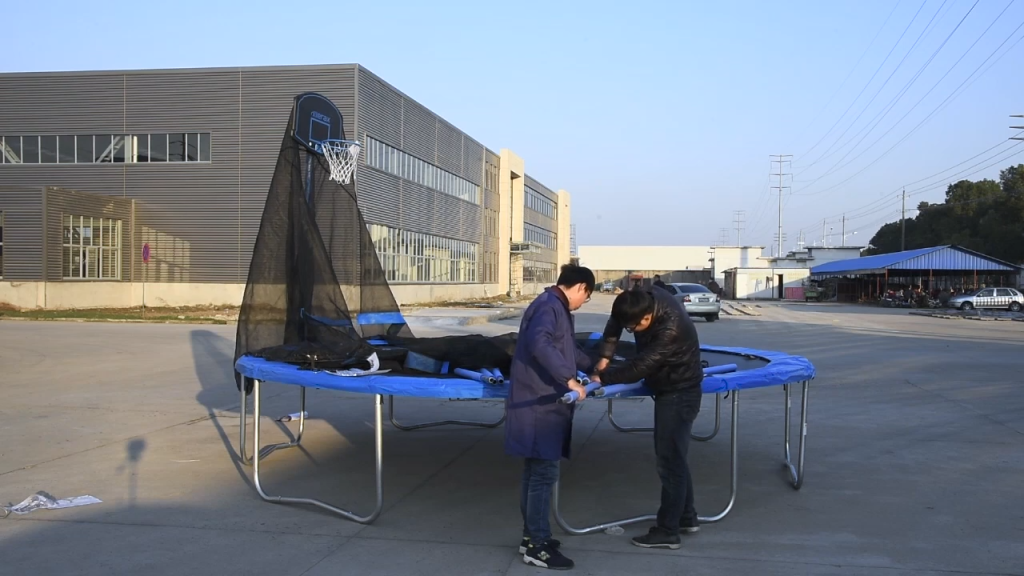
If you’re considering installing an inground trampoline, it’s important to make sure it’s done correctly and safely. One way to ensure this is by hiring a professional installation service.
We’ll discuss the importance of professional installation, the cost, and where to find professionals to do the job.
Importance of Professional Installation
Professional installation of an inground trampoline is crucial for several reasons. First and foremost, it ensures the safety of those using the trampoline. Trampolines can be dangerous if not installed properly, and a professional installer will have the knowledge and experience to make sure everything is done correctly.
This includes ensuring that the trampoline is level and secure and that all of the necessary safety features are in place.
Another important reason to hire a professional installation service is to protect your investment. Trampolines can be expensive, and you don’t want to risk damaging or ruining it by installing it improperly.
A professional installer will have the tools and expertise to make sure your trampoline is installed correctly and will last for years to come.
Cost of Professional Installation
The cost of professional installation will vary depending on a few factors. The size and complexity of the installation will play a role, as well as the location of your property. The cost may also vary depending on the specific company you choose to work with.
On average, you can expect to pay anywhere from $500 to $1500 for the professional installation of an inground trampoline. While this may seem like a high cost, it’s important to remember the benefits of hiring a professional. Professional installation can save you time, money, and stress in the long run.
Where to Find Professional Installation Services
When looking for a professional installation service, it’s important to do your research. Look for companies with experience installing inground trampolines and good reviews from previous customers. You can also ask for recommendations from friends or family who have installed trampolines.
Another option is to work directly with the trampoline manufacturer. Many companies offer installation services for their products, which can be a convenient and reliable option. Just do your research and compare prices and services before making a decision.
Optional Accessories
Trampolines are a popular and exciting outdoor activity for kids and adults alike. They provide an excellent source of physical exercise and can be a fun way to spend time outdoors with friends and family. While a trampoline on its own is a great addition to any backyard, several optional accessories can enhance the experience even further.
We’ll review some of the most popular optional accessories for trampolines and explain the benefits of each.
Safety Enclosure
One of the most important optional accessories for any trampoline is a safety enclosure. A safety enclosure is a net that surrounds the trampoline and prevents jumpers from falling off it and injuring themselves.
Safety enclosures are essential for families with young children or trampolines placed in areas with hard surfaces nearby. A safety enclosure can prevent serious injuries and give parents peace of mind while their children jump on the trampoline.
Ladder
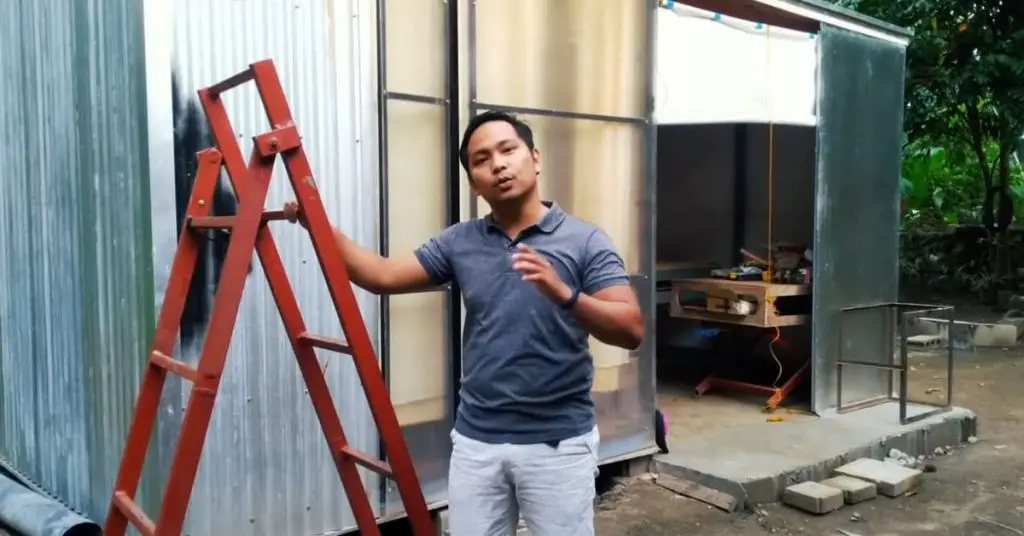
Another useful optional accessory for trampolines is a ladder. A ladder provides an easy and safe way for jumpers to get onto and off of the trampoline. Without a ladder, jumpers may be tempted to climb onto the trampoline unsafely, which could lead to injury. A ladder also makes it easier for adults to access the trampoline, especially if it is higher off the ground.
Weather Cover
A weather cover is an optional accessory that can protect your trampoline from the elements. A weather cover can help prevent rust, fading, and other damage caused by exposure to the sun, rain, and snow. Weather covers are especially useful for trampolines that are kept outdoors year-round or in areas with harsh weather conditions.
Anchor Kit
An anchor kit is an optional accessory that can be used to secure the trampoline to the ground. This is especially useful in areas with high winds, where the trampoline could be blown over and cause damage or injury. An anchor kit typically includes stakes driven into the ground around the trampoline, which are then attached to the trampoline frame.
Basketball Hoop
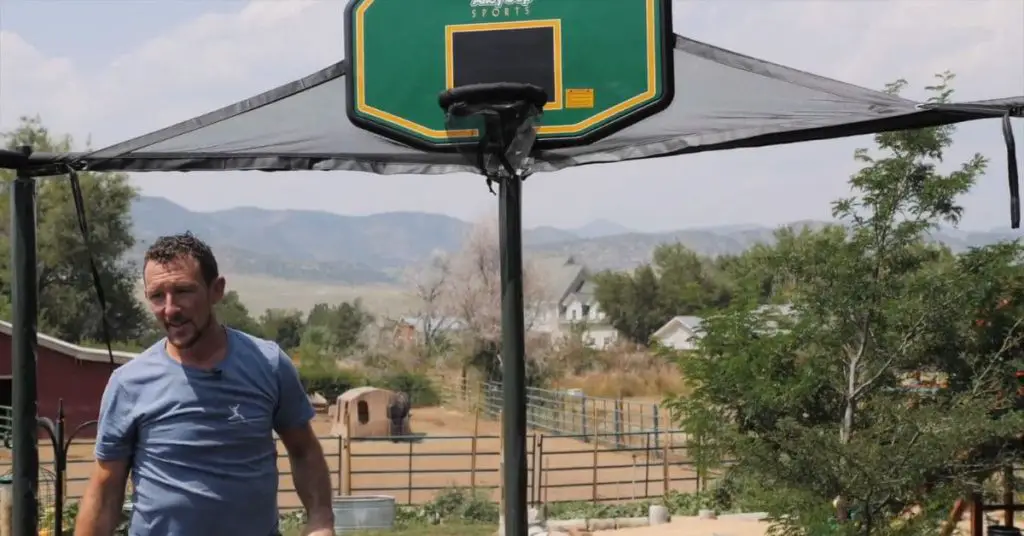
A basketball hoop is a great option for those who want to add an extra element of fun to their trampoline. A basketball hoop can be attached to the enclosure net, providing hours of entertainment for jumpers. It can also be a fun way for kids to practice their basketball skills and improve their coordination.
LED Lights
LED lights are an optional accessory that can be attached to the frame of the trampoline or to the enclosure net. LED lights can provide a fun and unique look to the trampoline, especially at night. They can also make it easier for jumpers to see and can provide an extra level of safety when jumping in low-light conditions.
FAQs
Q.1 What types of trampolines are available for installation?
There are two main types of trampolines: above-ground and inground. Above-ground trampolines sit on top of the ground and are supported by metal frames and legs. Inground trampolines are installed flush with the ground.
Q.2 What are the benefits of an inground trampoline?
Inground trampolines offer a sleeker look that blends in with the landscape, and they can be safer as they have a lower profile and are less likely to tip over. They also tend to last longer as they are less exposed to the elements.
Q.3 How deep does the hole for an inground trampoline need to be?
The depth of the hole will depend on the size of the trampoline and the manufacturer’s recommendations, but generally, it needs to be at least 2 feet deep to allow for proper air circulation and drainage.
Q.4 Can I install a trampoline myself?
While it is possible to install a trampoline yourself, it is recommended that you hire a professional for safety reasons. Trampoline installation can be a complex process, and professionals have the tools and expertise to ensure that it is done correctly.
Q.5 How much does professional trampoline installation cost?
The cost of professional trampoline installation can vary depending on a number of factors, including the size and type of trampoline, the location of the installation, and any additional features like retaining walls or drainage systems. Generally, you can expect to pay anywhere from $500 to $1500 for professional installation.
Q.6 What optional accessories are available for trampolines?
There are a variety of accessories available for trampolines, including safety enclosures, ladder systems, weather covers, and anchor kits. These accessories can enhance the safety and longevity of your trampoline.
Q.7 How often should I perform maintenance on my trampoline?
Regular maintenance is important to ensure the safety and longevity of your trampoline. You should visually inspect your trampoline every few weeks to check for signs of wear or damage, and replace any worn or damaged parts as necessary. You should also clean your trampoline regularly to remove dirt and debris and store it properly during the off-season to prevent damage from the elements.
Conclusion
In conclusion, installing a trampoline can provide endless hours of fun and entertainment for you and your family. Understanding the costs associated with above-ground and inground trampolines and the various optional accessories available can help you decide when to choose the right trampoline for your needs.
It’s important to consider factors such as hole depth, retaining walls, and water drainage when installing an inground trampoline and the benefits of professional installation.
Investing in optional accessories like a safety enclosure, ladder, weather cover, anchor kit, basketball hoop, and LED lights can enhance your trampoline experience and provide added safety measures. By considering these factors and making informed choices, you can enjoy the benefits of owning a trampoline while ensuring the safety and enjoyment of everyone who uses it.
We hope this guide has given you a good understanding of how much it costs to install a trampoline. If you have any questions, please feel free to ask by commenting below!

